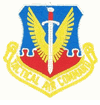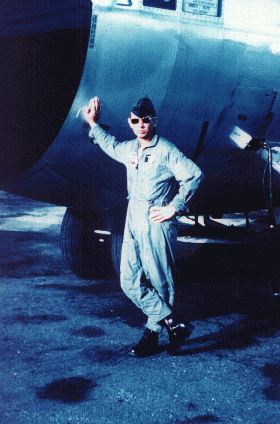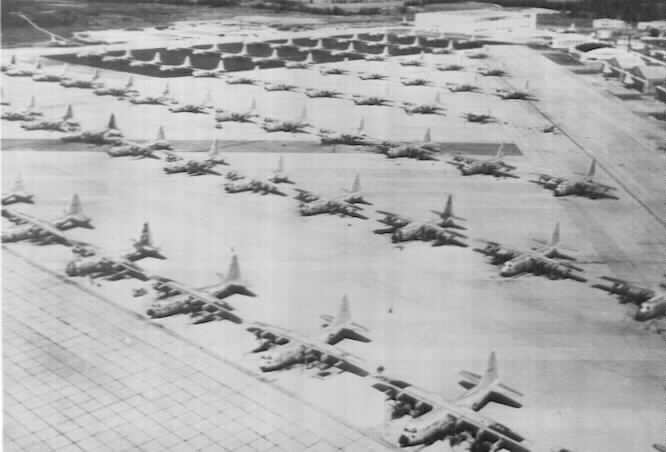


In December, 1963 I stepped out of a bus in front of the
service club at Pope AFB, North Carolina and entered the world of the
TAC-Trained Killers for the first time. Pope was home to the 464th Troop Carrier
Wing, which was one of four TAC C-130 wings at the time. The others were the
314th at Sewart, the 463rd at Langely and the 516th at Dyess. A fifth wing, the
317th, was in France at Evruex and would be returning to the US within a few
months to take up residence at Lockbourne, Ohio while plans were underway to
create a sixth TAC C-130 wing at Forbes AFB, Kansas.
It didn't matter
which base a person was at, troop carrier life in TAC was the same. General
Walter Sweeny was the TAC commander at the time and he dictated that his troops
would "look sharp." Our mission was working with the Army, particularly the 82nd
and 101st Airborne Divisions, and General Sweeny did not want his men to be an
embarrassment when they appeared in the presence of the paratroopers. Dress for
airmen was fatigues complete with blue name tags and aircrew badge, a TAC patch
over the right pocket and a blue scarf when off the flight line. Officers
usually wore the tan 505 and 1505 short sleeve Class B uniform and blues during
the winter. Our flight suits were olive-green cotton - this was before the days
of Nomex - and we wore the same blue dickie that was prescribed for the dress
fatigue uniform.
While TAC troop carrier crews had once occupied a very
low rung on the Air Force ladder, they had progessed upwards somewhat with the
advent of the C-130. Our mission in TAC was two-fold, to support the Army's
airborne and light infantry units and to provide logistical support for TAC's
own fighter and photo-recon squadrons during overseas deployments and on
exercises in the United States. The Vietnam War was in its beginnings, but at
that time it was still in the advisory stage and being "fought" by the Air
Commandos from down at Eglin, though the first USAF transports so see duty in
Vietnam had been TAC C-123s from right there at Pope. I guess we should have
known, but in 1964 very few C-130 crewmembers had any idea they would be flying
combat in Vietnam.
A TAC C-130 troop carrier squadron was always involved
in training. For those of us at Pope, it meant flying "around the flagpole"
until we reached "Combat Ready" aircrew status, then it was off TDY on
deployment somewhere overseas, which in the case of the 464th in 1964 meant
Evruex, France or Leopoldville in the Congo. For the Sewart, Langely and Dyess
crews, training meant either coming to Pope or going to Ft. Campbell. In either
case, the training involved a lot of low-level flying followed by an airdrop of
either cargo or personnel on one of the DZs at the two US Army airborne
bases.
In the mid-sixties TAC was placing heavy emphasis on the
low-altitude "Close Look" in-trail formation that was designed to approach a
drop zone below an enemy's radar fence. TAC troop carrier wings were committed
to the US Strike Command, whose mission was to deploy Composite Air Strike
Forces supported by US Army airborne and infantry forces overseas at a moment's
notice. TAC training was to be ready to deploy.
In early August, 1964
reality struck home to the troop carrier wings when the Gulf of Tonkin crisis
led to the deployment of TAC squadrons to the Pacific. Sewart and Langely both
deployed C-130 squadrons, along with Dyess though the Dyess squadron did not
stay. The squadrons from the 314th and 463rd remained in the Pacific, supporting
PACAF's 315th Air Division.
In November, 1964 the whole world found out
just how good TAC's troop carrier wings where when a squadron from the 464th
airlifted Belgian paratroopers to the Congo and then airdropped them onto
Stanleyville Airport at dawn on November day. News of the rescue made headlines
all over the world, though TAC's rivals in MATS tried to take credit for the
mission. Though the airplanes and crews were TAC, they had been TDY to 322nd Air
Division in Europe, and 322nd had switched to MATS a few weeks before the
mission. The MATS PIO put out a news release "MATS Rescues Hostages in Congo"
but, needless to say, that did not set to well with TAC Headquarters since the
Congo was a Strike Command show.
There was a lot of rivalry between TAC
troop carrier and MATS in those days, and the rivalry was made worse by the MATS
PIO, who seemed to think that anything having to do with airlift naturally fell
under their responsibility. MATS had their own C-130s and they were required to
maintain tactical proficiency, but most of their flying was scheduled cargo
missions in the MATS system.
TAC crews in the sixties were generally
relatively young and low in rank, especially in comparison to MATS flight crews.
Most TAC aircraft commanders were captains and some were even first lieutenants,
with only three or four majors in a squadron. Enlisted men were usually below
the rank of Technical Sergeant. MATS' manning documents called for higher ranks
than TAC, which was another sore point because promotions came faster in the
military airline business than they did in the combat squadrons.
But it
was the 1960s, and as Bob Dylan was singing, "times, they are a'changing."
Vietnam was heating up, MATS was becoming MAC, the C-141 was starting to come
into service and it would not be long before the TAC-Trained Killers of TAC
would be doing what they had been trained to do.
Click Pope to return.

The flight line at Sewart AFB, Tennessee in the early 1960s.